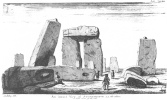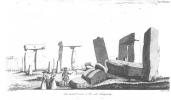
Sacred Texts Legends & Sagas England Index Previous Next


Stonehenge, A Temple Restor'd to the British Druids, by William Stukeley, [1740], at sacred-texts.com

Click to enlarge
Plate 21. An inward View of Stonehenge or Side view of the cell. AA the altar.
Of the Cursus. Games exercis’d on holy festivals. The Druids understood geometry.
ABOUT half a mile north of Stonehenge, across the first valley, is the cursus or hippodrom, which I discover’d august 6. 1723. ’Tis a noble monument of antiquity: and illustrates very much the preceding account of Stonehenge. It was the universal custom, to celebrate games, feasts, exercises and sports, at their more publick and solemn meetings to sacrifice. Which was done quarterly and anniversarily, at certain stated seasons of the year. Macrob. Satur. I. says, "Upon holy days dedicated to the gods, there are sacrifices, feasts, games and festivals. For a sacred solemnity is, when sacrifices are offer’d to the gods, or holy feastings celebrated, or games perform’d to their honour, or when holy days are observ’d." This great work is included between two ditches running east and west in a parallel, which are 350 foot asunder. When I mention 350 foot, I speak in the gross, and as we should set it down in an English scale: but if we look into Plate VI. where I have given a TAB. VI. comparative view of our English foot, and the most ancient cubit; at first sight we discern, this measure means 200 of the Druid cubits. This cursus is a little above l0000 foot long: that is, it is made of 6000 Druid cubits in length. A most noble work, contriv’d to reach from the highest ground of two hills, extended the intermediate distance over a gentle valley: so that the whole cursus lies conveniently under the eye of the most numerous quantity of spectators. To render this more convenient for sight, it is projected on the side of rising ground, chiefly looking southward toward Stonehenge. A delightful prospect from the temple, when this vast plain was crouded with chariots, horsemen and foot, attending these solemnities, with innumerable multitudes! This cursus, which is two miles long, has two entrances (as it were:) gaps being left in the two little ditches. And these gaps, which are opposite to each other, in the two ditches, are opposite to the strait part of Stonehenge avenue.
I mention’d before, that at the bottom of the strait part of Stonehenge avenue, TAB XXVIII.in the valley, the avenue divides itself into two parts. One goes directly east toward Radfin, the other goes northwestward, and enters our cursus nearly at the same distance west from the gaps or entrances before-mention’d: as those gaps are from the east end of the hippodrom. These gaps being at a convenient distance from that east end, may be thought to be in the nature of distance posts. It seems to me, that the turf of the adjacent ground on both sides, has been originally taken off, and laid on the whole length of this cursus, because it appears somewhat higher in level. Tho’ this was an incredible labour, yet a fine deign for the purpose of running. The earth of the vallum is likewise thrown inward.
The eat’ end of the cursus is compos’d of a huge body of earth, a bank orTAB. XXIX. long barrow, thrown up nearly the whole breadth of the cursus. This seems to be the plain of session, for the judges of the prizes, and chief of the spectators. The west end of the cursus is curv’d into an arch, like the end of the Roman circus's. And there probably the chariots ran round, in order to turn again. And there is an obscure barrow or two, round which they return’d, as it were, a meta.
This is the finest piece of ground that can be imagin’d for the purpose of a horse-race. The whole is commanded by the eye of a spectator in any part. In the middle is a valley, and pretty steep at present: yet only so, as that a
[paragraph continues] British charioteer may have a good opportunity of showing that dexterity, spoken of by Cæsar. But the exquisite softness of the turf prevents any great damage by a fall. The ground of it hereabouts declines somewhat northward. The main part of this hippodrom is upon a gentle ridge running east and west. This render’d the place cooler.
On the southern ridge, toward the west end of it, are many considerable barrows: but none towards the east end, for that would obstruct the view of Stonehenge. There are many barrows but of no considerable bulk, on the north-side, upon the extensive ascent, toward the great north long barrow. This magnificent work of the cursus is drawn due east and west: except a small variation of 4 or 5 degrees southward from the east. If we measure along the bank, TAB. XXIX. from the eastern meta, at 700 cubits exactly, we come over against the middle line of the strait part of the avenue to Stonehenge: 500 cubits further conducts us to the gaps or opposite entrances, I before mention’d; which we suppose as distance posts. The whole interval between the eastern meta and these gaps, is 1200 cubits. At 1000 cubits more, we come to the place where the west wing of the avenue enters the southern ditch of the cursus. That west wing too, is just 1000 cubits long to its union, with the strait part of Stonehenge avenue. Likewise the strait part of Stonehenge avenue is just TAB. XXVIII. cubits long, as mention’d in its proper place. This west wing begins, in the bottom of that valley, which crosses the middle of the cursus and sweeping along by the bottom of the hill, in a gentle curve, meets with the lower end of the strait part of Stonehenge avenue, where the wing or avenue unites to it, with an equal angle. So that the whole work is laid out with great judgment and symmetry; and curiously adapted to the ground, which was well consider’d, before the plot was mark’d out, by the first surveyors. From the bottom of the valley crossing the middle of the cursus, to the western meta is TAB XXX. 3800 cubits more, making in the whole 6000 cubits. The north end of the eastern meta does not extend so far as the northern bank of the cursus: I suppose, the reason is, that there might be liberty that way, to stop the horses, at the end of the course. Therefore they set out, on the south side of the cursus and return’d by the north side. I observe the ditch and bank towards the eastern end of the cursus much obscur’d, by the trampling of men and horses, frequenting the spectators here: this being the most throng’d.
The Cursus is directly north from Stonehenge: so exactly, that the meridian line of Stonehenge passes precisely thro’ the middle of the Cursus. And when we stand in the grand entrance of Stonehenge and observe the two extremities of the Cursus the eastern and western meta, they are each exactly 60 degrees from the meridian line; on each hand: making a third part of the circle of the horizon. By which we see, the Druids well understood the geometry of a circle, and its measure of 360 parts.
Pausanias in Beotic. says, 'among the Thebans, by the gate Prætis is the Gymnasium of Jolaus and likewise the stadium, which is a bank of earth thrown up, such as that at Olympia and of the Laurii. In the same place is the heroical monument of Jolaus. A little beyond, to the right is the hippodrom, and in it Pindar's monument. The same author in Arcad. VIII. writes, that before the walls of Mantinea, in a field, was a stadium made for horse-races, in honour of Antinous. Not far from it was the temple of Neptunus equestris and others.' So that we see it was the manner of the ancient Greeks thus to define their places for sports by banks of earth, and that near their temples.
After the Romans had borrow’d the use of the British chariots for travelling and the like, they us’d them too in the Circensian games. Thus Sidonius Apollinaris his poem upon it, Lib. XXII.

Click to enlarge
Plate 22: An inward view of the Cell obliquely
Again,
Such, we may well imagine, was the scene of this place, in ancient days. And as the poet mentions the river Arar, I may take notice, in passing, that I have seen, several other places of sports and racings, which I take to have belong'd to the ancient Britons. As particularly those two great banks call’d Rawdikes in the meadow near Leicester, which spectators look on as unaccountable. Another such work, I have seen in the meadow by Dorchester, the ancient Roman city and episcopal see, in Oxfordshire. Both are by the side of rivers. Another upon the river Lowther by Perith in Cumberland.
These places by rivers, were more agreeable to the Greek taste, as in a hotter country. Another like place of sports, was in the chalky valley just without the town of Royston, on the south side of it, by the London road. The old Roman road there, or Hermen-street passes over one corner of the work, as being of later date. I may, perhaps, describe these more largely, another time. We read in Homer and Virgil that races were celebrated at funerals.